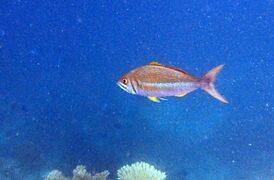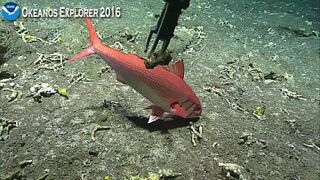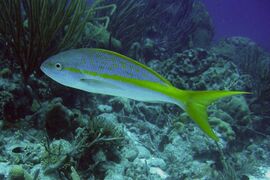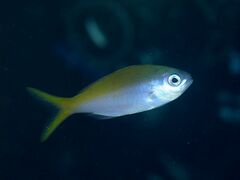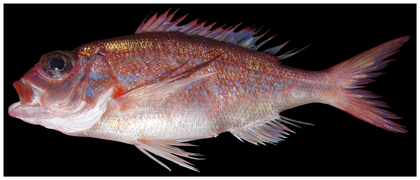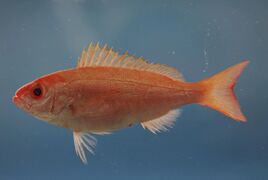Biology:Lutjanidae
| Lutjanidae | |
|---|---|
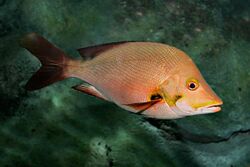
| |
| Humpback red snapper, Lutjanus gibbus | |
| Scientific classification | |
| Domain: | Eukaryota |
| Kingdom: | Animalia |
| Phylum: | Chordata |
| Class: | Actinopterygii |
| Order: | Perciformes |
| Family: | Lutjanidae T. N. Gill, 1861[1] |
| Subfamilies | |
|
see text | |
Lutjanidae, or snappers are a family of perciform fish, mainly marine, but with some members inhabiting estuaries, feeding in fresh water. The family includes about 113 species. Some are important food fish. One of the best known is the red snapper.
Snappers inhabit tropical and subtropical regions of all oceans. Some snappers grow up to about 1 m (3.3 ft) in length, and one specific snapper, the cubera snapper, grows up to 1.52 m (5 ft 0 in) in length.[2] Most are active carnivores, feeding on crustaceans or other fish,[3] though a few are plankton-feeders. They can be kept in aquaria, but mostly grow too fast to be popular aquarium fish. Most species live at depths reaching 100 m (330 ft) near coral reefs, but some species are found up to 500 m (1,600 ft) deep.[3]
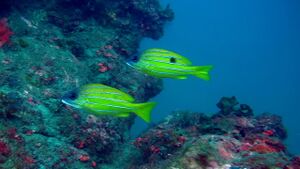
As with other fish, snappers harbour parasites. A detailed study conducted in New Caledonia has shown that coral reef-associated snappers harbour about 9 species of parasites per fish species.[4]
Timeline
Gibola <timeline> ImageSize = width:700px height:auto barincrement:15px PlotArea = left:10px bottom:50px top:10px right:10px
Period = from:-65.5 till:10 TimeAxis = orientation:horizontal ScaleMajor = unit:year increment:5 start:-65.5 ScaleMinor = unit:year increment:1 start:-65.5 TimeAxis = orientation:hor AlignBars = justify
Colors =
#legends id:CAR value:claret id:ANK value:rgb(0.4,0.3,0.196) id:HER value:teal id:HAD value:green id:OMN value:blue id:black value:black id:white value:white id:cenozoic value:rgb(0.54,0.54,0.258) id:paleogene value:rgb(0.99,0.6,0.32) id:paleocene value:rgb(0.99,0.65,0.37) id:eocene value:rgb(0.99,0.71,0.42) id:oligocene value:rgb(0.99,0.75,0.48) id:neogene value:rgb(0.999999,0.9,0.1) id:miocene value:rgb(0.999999,0.999999,0) id:pliocene value:rgb(0.97,0.98,0.68) id:quaternary value:rgb(0.98,0.98,0.5) id:pleistocene value:rgb(0.999999,0.95,0.68) id:holocene value:rgb(0.999,0.95,0.88)
BarData=
bar:eratop bar:space bar:periodtop bar:space bar:NAM1
bar:space bar:period bar:space bar:era
PlotData=
align:center textcolor:black fontsize:M mark:(line,black) width:25 shift:(7,-4) bar:periodtop from: -65.5 till: -55.8 color:paleocene text:Paleocene from: -55.8 till: -33.9 color:eocene text:Eocene from: -33.9 till: -23.03 color:oligocene text:Oligocene from: -23.03 till: -5.332 color:miocene text:Miocene from: -5.332 till: -2.588 color:pliocene text:Plio. from: -2.588 till: -0.0117 color:pleistocene text:Pleist. from: -0.0117 till: 0 color:holocene text:H.
bar:eratop from: -65.5 till: -23.03 color:paleogene text:Paleogene from: -23.03 till: -2.588 color:neogene text:Neogene from: -2.588 till: 0 color:quaternary text:Q.
PlotData=
align:left fontsize:M mark:(line,white) width:5 anchor:till align:left
color:eocene bar:NAM1 from: -55.8 till: 0 text: Apsilus
PlotData=
align:center textcolor:black fontsize:M mark:(line,black) width:25
bar:period from: -65.5 till: -55.8 color:paleocene text:Paleocene from: -55.8 till: -33.9 color:eocene text:Eocene from: -33.9 till: -23.03 color:oligocene text:Oligocene from: -23.03 till: -5.332 color:miocene text:Miocene from: -5.332 till: -2.588 color:pliocene text:Plio. from: -2.588 till: -0.0117 color:pleistocene text:Pleist. from: -0.0117 till: 0 color:holocene text:H.
bar:era from: -65.5 till: -23.03 color:paleogene text:Paleogene from: -23.03 till: -2.588 color:neogene text:Neogene from: -2.588 till: 0 color:quaternary text:Q.
</timeline>
Systematics
Lutjanidae is subdivided into four subfamilies and 17 genera with around 110 species, as follows:[5][6][1]
- subfamily Apsilinae Johnson, 1980
- genus Apsilus Valenciennes, 1830
- genus Lipocheilus Anderson, Talwar & Johnson, 1977
- genus Paracaesio Bleeker, 1875
- genus Parapristipomoides Kami, 1963
- subfamily Etelinae Gill, 1893
- genus Aphareus Cuvier, 1870
- genus Aprion Valenciennes, 1830
- genus Etelis Cuvier, 1828
- genus Pristipomoides Bleeker, 2020
- genus Randallichthys Anderson, Kami & Johnson, 1977
- subfamily Lutjaninae Gill, 1861
- genus Hoplopagrus Gill, 1861
- genus Lutjanus Bloch, 1790
- genus Macolor Bleeker, 1860
- genus Ocyurus Gill, 1862
- genus Pinjalo Bleeker, 1873
- genus Rhomboplites Gill, 1862
- subfamily Paradicichthyinae Whitley, 1930
- genus Symphorichthys Munro, 1967
- genus Symphorus Günther, 1872
Some authorities classify the Caesionidae, the fusiliers, within the Lutjanidae as a fifth subfamily but the 5th Edition of Fishes of the World retains this grouping as a distinct family pending more work being conducted on its relationships.[5]
-
Aprion virescens
-
Etelis radiosus
-
Lutjanus kasmira
-
Macolor macularis
-
Ocyurus chrysurus
-
Pinjalo pinjalo
-
Pristipomoides aquilonaris
-
Rhomboplites aurorubens
-
Symphorichthys spilurus
References
- ↑ 1.0 1.1 Richard van der Laan; William N. Eschmeyer; Ronald Fricke (2014). "Family-group names of Recent fishes". Zootaxa 3882 (2): 001–230. doi:10.11646/zootaxa.3882.1.1. PMID 25543675. https://biotaxa.org/Zootaxa/article/view/zootaxa.3882.1.1/10480.
- ↑ "Cubera Snapper". http://blog.mountthis.net/2017/02/cubera-snapper.html.
- ↑ 3.0 3.1 Bray, Dianne. "LUTJANIDAE". http://www.fishesofaustralia.net.au/home/family/308.
- ↑ Justine, Jean-Lou; Beveridge, Ian; Boxshall, Geoffrey A; Bray, Rodney A; Miller, Terrence L; Moravec, František; Trilles, Jean-Paul; Whittington, Ian D (2012). "An annotated list of fish parasites (Isopoda, Copepoda, Monogenea, Digenea, Cestoda, Nematoda) collected from Snappers and Bream (Lutjanidae, Nemipteridae, Caesionidae) in New Caledonia confirms high parasite biodiversity on coral reef fish". Aquatic Biosystems 8 (1): 22. doi:10.1186/2046-9063-8-22. ISSN 2046-9063. PMID 22947621.

- ↑ 5.0 5.1 J. S. Nelson; T. C. Grande; M. V. H. Wilson (2016). Fishes of the World (5th ed.). Wiley. pp. 457–458. ISBN 978-1-118-34233-6. https://sites.google.com/site/fotw5th/.
- ↑ Eschmeyer, William N.; Fricke, Ron; van der Laan, Richard, eds. "Genera in the family Lutjanidae". California Academy of Sciences. http://researcharchive.calacademy.org/research/ichthyology/catalog/fishcatget.asp?tbl=genus&family=Lutjanidae.
Wikidata ☰ Q849160 entry
 |
